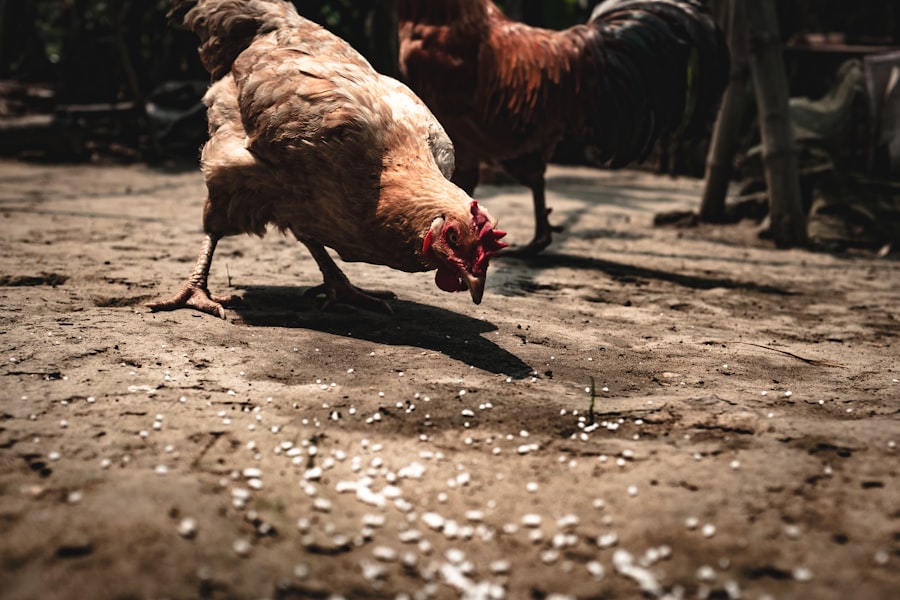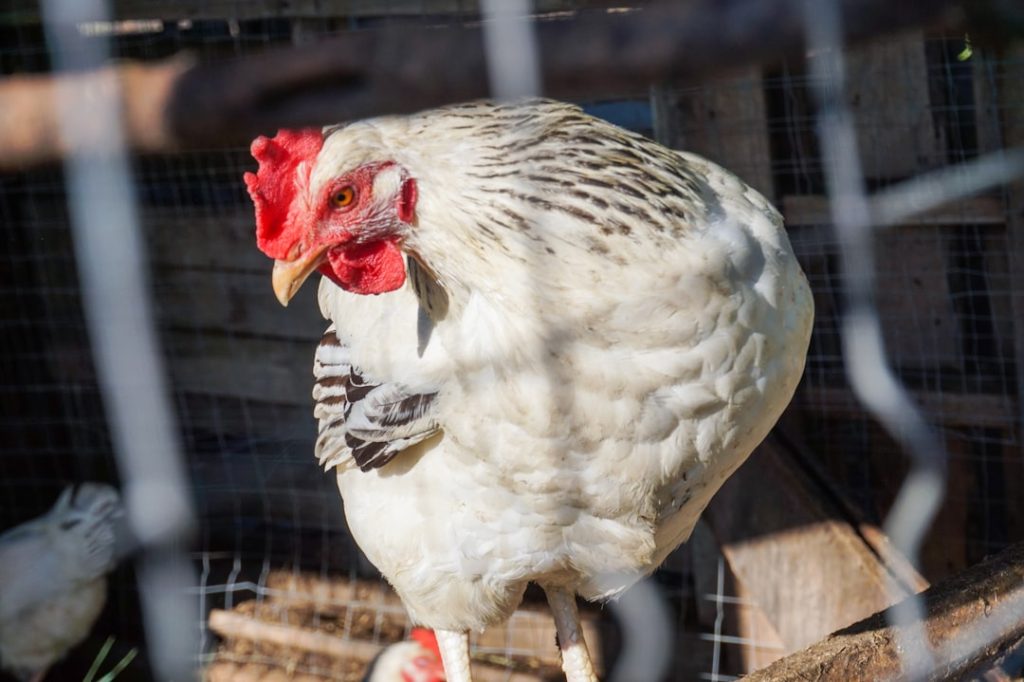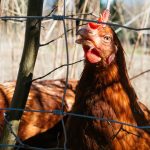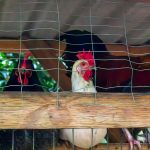Chickens are social animals with natural instincts for foraging, nesting, and roosting. As prey animals, they remain vigilant for potential threats. Understanding these behaviors is essential for effective predator protection.
Chickens are curious and exploratory, which can sometimes lead them into dangerous situations if not properly safeguarded. They also maintain a hierarchical pecking order within their flock, potentially resulting in aggression if not managed correctly. Chickens are creatures of habit, often following consistent daily routines.
This predictability can be advantageous for implementing effective predator prevention strategies, as it allows owners to anticipate their movements and behaviors. However, it also makes chickens vulnerable to predators that may learn and exploit these patterns. To counter this, chicken owners should regularly vary their security measures to maintain an element of unpredictability.
By comprehending chicken behavior, owners can develop targeted strategies to protect their flock and ensure their safety and well-being. This knowledge enables proactive measures to be taken, anticipating potential risks and implementing appropriate safeguards.
Table of Contents
Key Takeaways
- Chickens are social animals and their behavior is influenced by their environment and interactions with other chickens.
- Pigeon spikes can be installed on fences to prevent chickens from perching and roosting on them.
- Creating a physical barrier such as a wire mesh or netting can effectively keep chickens out of certain areas.
- Visual deterrents like scarecrows or reflective objects can help deter chickens from entering specific areas.
- Training and behavioral modification techniques can be used to teach chickens to avoid certain areas or behaviors.
- Regular maintenance and inspection of barriers and deterrents is important to ensure their effectiveness.
- Seeking professional help may be necessary if the chicken behavior problem persists despite other efforts.
Installing Pigeon Spikes on the Fence
Physical Barrier Against Predators
One effective way to deter predators from accessing a chicken coop is by installing pigeon spikes on the fence surrounding the coop. Pigeon spikes are designed to prevent birds and other small animals from landing or perching on surfaces, making them an ideal deterrent for predators such as hawks, owls, and other birds of prey. These spikes are typically made of durable materials such as stainless steel or plastic, and they can be easily attached to the top of a fence using screws or adhesive.
Multi-Layered Protection
By installing pigeon spikes on the fence, chicken owners can create a physical barrier that prevents predators from gaining access to the coop and its inhabitants. In addition to deterring predators, pigeon spikes can also help to protect chickens from other potential threats, such as rodents and other pests. These spikes create an inhospitable environment for these animals, making it less likely that they will attempt to breach the coop’s defenses.
Humane and Non-Lethal Solution
Furthermore, pigeon spikes are a humane and non-lethal method of predator prevention, making them an ideal choice for chicken owners who want to protect their flock without causing harm to other wildlife. By installing pigeon spikes on the fence surrounding the chicken coop, owners can create a safe and secure environment for their chickens to thrive.
Creating a Physical Barrier

Another effective way to protect chickens from predators is by creating a physical barrier around the coop and run area. This can be achieved by installing hardware cloth or welded wire fencing around the perimeter of the coop, as well as burying the fencing underground to prevent predators from digging underneath it. Additionally, adding a roof or cover to the run area can further enhance the security of the coop and protect chickens from aerial predators such as hawks and owls.
Creating a physical barrier not only prevents predators from gaining access to the chickens, but it also provides peace of mind for chicken owners knowing that their flock is safe and secure. When creating a physical barrier, it’s important to ensure that all potential entry points are secured, including doors, windows, and vents. Predators are known for their persistence and ingenuity when it comes to finding ways to access a potential food source, so it’s crucial to be thorough in fortifying the coop against any potential threats.
Additionally, regular maintenance and inspection of the physical barrier is essential to ensure that it remains effective over time. By creating a physical barrier around the chicken coop, owners can significantly reduce the risk of predation and provide a safe and secure environment for their flock to thrive.
Using Visual Deterrents
Visual deterrents can be an effective way to deter predators from targeting a chicken coop. One common visual deterrent is the use of scarecrows or predator decoys, such as fake owls or hawks, which can create the illusion of a larger predator presence in the area. These decoys can be strategically placed around the coop and run area to create a sense of danger for potential predators, causing them to think twice before attempting to approach the chickens.
Additionally, reflective materials such as aluminum foil strips or CDs can be hung around the coop to create flashes of light that may startle and deter predators from getting too close. Another visual deterrent that can be effective in protecting chickens from predators is the use of motion-activated lights or sound devices. These devices are designed to detect movement or sound in the area surrounding the coop and emit a bright light or loud noise in response.
This sudden burst of light or sound can startle predators and discourage them from approaching the coop, helping to keep chickens safe from harm. By using visual deterrents, chicken owners can create an added layer of protection for their flock and reduce the risk of predation.
Implementing Training and Behavioral Modification
In addition to physical barriers and visual deterrents, implementing training and behavioral modification techniques can help to protect chickens from predators. One effective method is to train chickens to seek shelter in the coop at certain times of day when predators are most active, such as at dusk or dawn. By consistently rewarding chickens for returning to the coop during these times, owners can help to reinforce this behavior and reduce the risk of predation during vulnerable periods.
Additionally, providing hiding spots and cover within the run area can give chickens a safe place to retreat if they sense danger approaching. Another behavioral modification technique is to use positive reinforcement training to teach chickens to recognize and respond to potential threats. By using treats or rewards to associate certain sounds or signals with danger, chickens can learn to be more alert and vigilant in the presence of predators.
This heightened awareness can help them avoid dangerous situations and increase their chances of survival in the event of an attack. By implementing training and behavioral modification techniques, chicken owners can empower their flock with the skills and instincts they need to stay safe in their environment.
Regular Maintenance and Inspection

Inspecting Physical Barriers and Entry Points
Regular maintenance and inspection of the chicken coop and its surrounding area are essential for ensuring that predator prevention measures remain effective over time. This includes checking for any signs of wear or damage to physical barriers such as fencing or hardware cloth, as well as repairing any potential entry points that may have been compromised by predators or other wildlife. Additionally, ensuring that doors, windows, and vents are securely closed and latched can help to prevent predators from gaining access to the coop.
Maintaining Visual Deterrents and Electronic Devices
Regular inspection of visual deterrents such as scarecrows or predator decoys is also important to ensure that they remain effective in deterring predators. Over time, these deterrents may lose their effectiveness as predators become accustomed to their presence, so it’s important to periodically move or replace them to maintain their efficacy. Furthermore, checking motion-activated lights or sound devices for proper function and battery life is crucial for ensuring that they continue to provide protection for the flock.
Proactive Measures for a Safe Flock
By conducting regular maintenance and inspection of predator prevention measures, chicken owners can proactively address any potential vulnerabilities and keep their flock safe from harm.
Seeking Professional Help if Necessary
In some cases, despite best efforts in implementing predator prevention measures, chicken owners may find themselves facing persistent predation issues that require professional assistance. If predation continues despite efforts to deter predators, it may be necessary to seek help from wildlife experts or pest control professionals who specialize in predator management. These professionals can assess the situation and provide guidance on additional measures that can be taken to protect the flock from predation.
Additionally, seeking professional help may also involve exploring options for humane trapping or relocation of persistent predators that pose a threat to the flock. Wildlife experts have the knowledge and experience necessary to safely capture and relocate predators without causing harm to them or other wildlife in the area. By seeking professional help when necessary, chicken owners can gain valuable insight and support in addressing predation issues and protecting their flock from harm.
In conclusion, understanding the behavior of chickens is crucial for implementing effective predator prevention measures that keep them safe from harm. Installing pigeon spikes on the fence creates a physical barrier that deters predators from accessing the coop, while visual deterrents such as scarecrows and motion-activated devices provide added protection. Implementing training and behavioral modification techniques empowers chickens with the skills they need to recognize and respond to potential threats, while regular maintenance and inspection ensure that predator prevention measures remain effective over time.
In cases where predation issues persist despite best efforts, seeking professional help may be necessary to address the situation effectively. By taking proactive measures to protect their flock from predators, chicken owners can create a safe and secure environment for their chickens to thrive.
If you’re looking for ways to keep your chickens safe and secure in their coop, you may want to consider installing pigeon spikes on the top of the fence. Pigeon spikes can help prevent chickens from jumping over the fence and escaping. For more tips on keeping your chickens safe and happy, check out this article on where to put your chicken coop. This article provides valuable information on the best location for your chicken coop to ensure the health and safety of your flock.
FAQs
What are pigeon spikes?
Pigeon spikes are devices designed to prevent birds, such as pigeons, from landing or roosting on certain surfaces. They are typically made of plastic or metal and feature pointed spikes that make it uncomfortable for birds to land.
How can pigeon spikes be used to keep chickens from jumping over a fence?
Pigeon spikes can be installed along the top of a fence to deter chickens from attempting to jump or fly over it. The pointed spikes create an uncomfortable surface for the chickens to land on, discouraging them from attempting to escape.
Are pigeon spikes safe for chickens?
When installed properly, pigeon spikes are safe for chickens. The spikes are designed to be a deterrent rather than a harmful device, and they do not cause any harm to the chickens. It is important to ensure that the spikes are securely attached to the fence and do not pose a risk of injury to the chickens.
Where can pigeon spikes be purchased?
Pigeon spikes can be purchased from hardware stores, garden centers, or online retailers. They are available in various lengths and materials to suit different types of fences and surfaces.
Are there any alternative methods for keeping chickens from jumping over a fence?
In addition to using pigeon spikes, other methods for keeping chickens from jumping over a fence include clipping their wings, installing netting or wire mesh over the top of the fence, or using deterrent sprays or noise devices to discourage them from attempting to escape.
Meet Walter, the feathered-friend fanatic of Florida! Nestled in the sunshine state, Walter struts through life with his feathered companions, clucking his way to happiness. With a coop that’s fancier than a five-star hotel, he’s the Don Juan of the chicken world. When he’s not teaching his hens to do the cha-cha, you’ll find him in a heated debate with his prized rooster, Sir Clucks-a-Lot. Walter’s poultry passion is no yolk; he’s the sunny-side-up guy you never knew you needed in your flock of friends!







